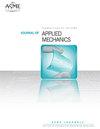Bounds on the Poisson's ratios of diamond-like structures
IF 2.8
4区 工程技术
Q2 MECHANICS
引用次数: 0
Abstract
Poisson's ratios of diamond-like structures, such as cubic C, Si, and Ge, have been widely explored because of their potential applications in solid-state devices. However, the theoretical bounds on the Poisson's ratios of diamond-like structures remain unknown. In this paper, we have derived analytical expressions for the minimum and maximum Poisson's ratios, as well as the Poisson's ratios averaged by three different schemes (i.e., Voigt, Reuss, and Hill averaging schemes). These expressions are based on the correlation between macroscopic elastic constants and microscopic force constants of diamond-like structures, and are solely a function of a dimensionless quantity (λ) that characterizes the ratio of mechanical resistances between angle bending and bond stretching. Based on these expressions, we have determined the bounds on the Poisson's ratios, as well as the minimum and maximum Poisson's ratios, and the Poisson's ratios averaged by the three schemes mentioned above. Specifically, these bounds are (−1, 4/5), (−1, 1/5), (0, 4/5), (−1, 1/2), (−1/3, 1/2), and (−2/3, 1/2), respectively. These results were well supported by atomistic simulations. Mechanism analyses demonstrated that the diverse Poisson's behaviors of diamond-like structures result from the interplay between two deformation modes (i.e., bond stretching and angle bending). This work provides the roadmap for finding interesting Poisson's behaviors of diamond-like structures.类金刚石结构泊松比的界
类金刚石结构(如立方C、Si和Ge)的泊松比由于其在固态器件中的潜在应用而被广泛探索。然而,类金刚石结构泊松比的理论界限仍然未知。在本文中,我们导出了最小和最大泊松比的解析表达式,以及三种不同方案(即Voigt、Reuss和Hill平均方案)平均的泊松比。这些表达式基于类金刚石结构的宏观弹性常数和微观力常数之间的相关性,并且仅仅是表征角度弯曲和键拉伸之间的机械阻力比的无量纲量(λ)的函数。基于这些表达式,我们确定了泊松比的边界,以及最小和最大泊松比,以及由上述三种方案平均的泊松比。具体而言,这些边界分别为(−1,4/5)、(−1、1/5)、(0,4/5。这些结果得到了原子模拟的有力支持。机理分析表明,类金刚石结构的不同泊松行为是两种变形模式(即键拉伸和角弯曲)相互作用的结果。这项工作为寻找类金刚石结构有趣的泊松行为提供了路线图。
本文章由计算机程序翻译,如有差异,请以英文原文为准。
求助全文
约1分钟内获得全文
求助全文
来源期刊
CiteScore
4.80
自引率
3.80%
发文量
95
审稿时长
5.8 months
期刊介绍:
All areas of theoretical and applied mechanics including, but not limited to: Aerodynamics; Aeroelasticity; Biomechanics; Boundary layers; Composite materials; Computational mechanics; Constitutive modeling of materials; Dynamics; Elasticity; Experimental mechanics; Flow and fracture; Heat transport in fluid flows; Hydraulics; Impact; Internal flow; Mechanical properties of materials; Mechanics of shocks; Micromechanics; Nanomechanics; Plasticity; Stress analysis; Structures; Thermodynamics of materials and in flowing fluids; Thermo-mechanics; Turbulence; Vibration; Wave propagation

 求助内容:
求助内容: 应助结果提醒方式:
应助结果提醒方式:


